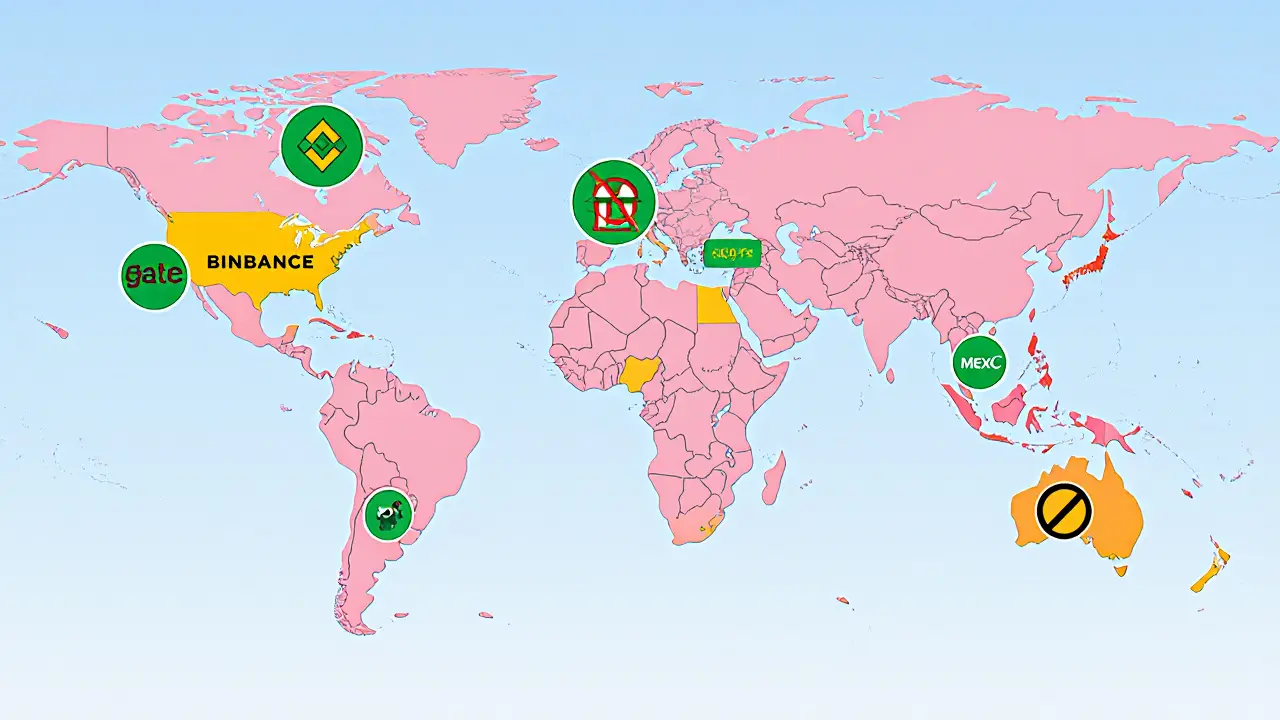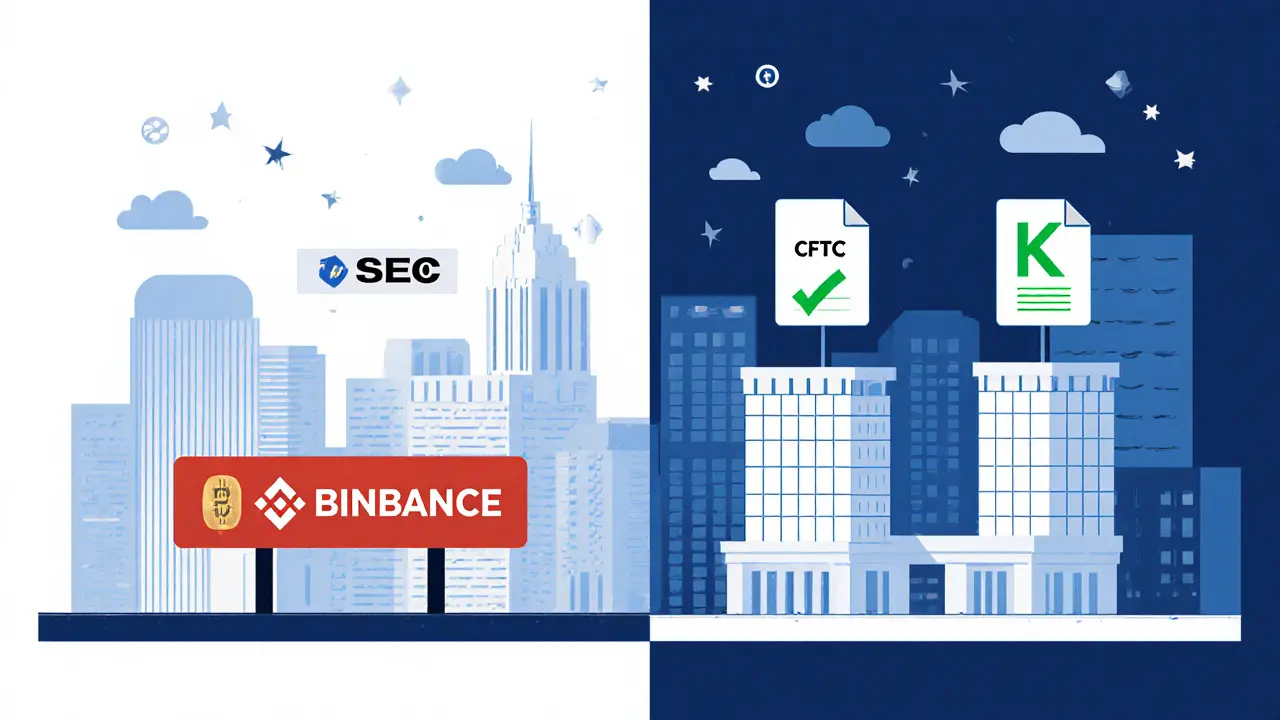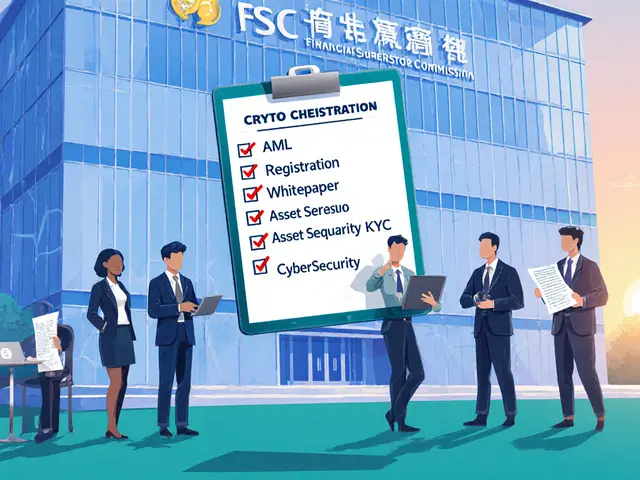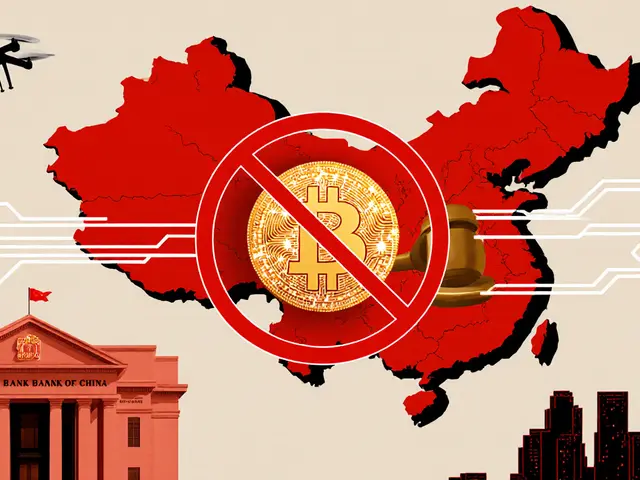- Home
- ::
- Crypto Exchange Availability by Region Worldwide - 2025 Overview

Crypto Exchange Availability by Region Worldwide - 2025 Overview
Crypto Exchange Availability Checker
Major Exchanges by Region
Regional Regulatory Status Guide
Cryptocurrency exchange is a platform that lets users buy, sell, and trade digital assets such as Bitcoin and Ethereum. Availability varies wildly across the globe because every country applies its own mix of rules, demand, and tech infrastructure. In 2025 the market is worth $48.41billion and is expected to hit $122.63billion by 2032, but that growth won’t be even. Below you’ll find the biggest drivers, the leading players and a quick reference to where you can actually trade today.
TL;DR - Key Points at a Glance
- Binance holds ~38% of global market share but is barred from most U.S. states.
- Gate.io, Bitget and MEXC fill gaps left by regulatory pressure on larger players.
- Eastern Europe (Ukraine, Moldova, Georgia) shows the highest adoption scores, driving strong local exchange ecosystems.
- Clear, supportive regulation = more exchanges; hostile rules = exits or limited services.
- Spot trading dominates (≈61% of volume) and is the most widely available product type.
Market Landscape in 2025
The global exchange market is dominated by a handful of centralized platforms. Binance processes about $23.97billion in 24‑hour trading volume, giving it a 38% share. Gate.io ranks second with a 9% share and $113.7billion spot volume. Bitget follows at 7.2%, while MEXC holds 8.6%.
The top‑10 exchanges together command roughly 46% of global volume, leaving the rest to a mix of regional specialists and emerging DeFi platforms. Spot trading still accounts for the lion’s share of activity - about 61.3% - because it’s simple, liquid and regulator‑friendly.
How Regulation Shapes Availability
Regulatory frameworks are the single biggest factor that determines whether an exchange can operate in a given jurisdiction.
- United States: A patchwork of SEC, CFTC, FinCEN and state‑level rules means most major exchanges create separate entities (e.g., Binance.US) or withdraw entirely. Binance’s $4billion settlement in 2023 forced a phased exit from the U.S. market.
- European Union: MiCA (Markets in Crypto‑Assets) is still rolling out, but most EU states allow full‑service exchanges with KYC/AML checks.
- Asia: HongKong, Singapore and SouthKorea have clear licensing pathways, attracting both global and local platforms.
- Emerging economies: Countries like Yemen, Venezuela and Jordan see high adoption because traditional banking is weak, yet many lack formal crypto regulations, creating a gray‑area market.
Where regulators are transparent and supportive, you’ll see multiple exchanges competing for users. Where rules are vague or hostile, you often get a single local player or a complete withdrawal.
Top Exchanges and Their Regional Footprint
| Exchange | Global Market Share | Primary Regions Served | Regulatory Status |
|---|---|---|---|
| Binance | 38% | Europe, Asia, Latin America, Middle East (excludes U.S.) | Operates local entities (e.g., Binance.US, Binance.TR) to meet jurisdictional rules |
| Gate.io | 9% | Eastern Europe, Southeast Asia, Africa | Registered in the Cayman Islands; complies with KYC/AML in most served countries |
| Bitget | 7.2% | SouthAmerica, SouthEast Asia, Middle East | Licensed in Singapore and Malta, uses local subsidiaries where required |
| MEXC | 8.6% | Asia‑Pacific, Africa | Operates under a HongKong licence; limited access in U.S. and Europe |
| Koinbay | ~2% | Europe (UK, Germany, France) | Fully FCA‑registered in the UK, compliant with EU MiCA draft |
Notice how each platform splits its services across different legal entities. That split is a direct response to the regulatory environment in each region.

Regional Adoption Hotspots
The 2025 Global Crypto Adoption Index puts three Eastern European nations at the top: Ukraine, Moldova and Georgia. High retail demand there pushes local exchanges to offer a full suite of spot pairs, fiat on‑ramps and even emerging DeFi bridges.
In Asia, HongKong SAR ranks fifth and Singapore sits at fifteenth. Both cities have clear licensing pathways, so you’ll find a dense cluster of both global and home‑grown platforms.
Countries with economic instability - Yemen (12th), Jordan (4th) and Venezuela (9th) - also rank high. Users in these markets gravitate to crypto as a hedge, but many rely on peer‑to‑peer (P2P) services when formal exchanges are blocked.
Decentralized Finance (DeFi) and Its Regional Impact
DeFi platforms sidestep many regulatory hurdles because they operate on‑chain without a central entity. However, they still face regional restrictions: some nations block access to known DeFi bridges or require users to pass KYC on third‑party aggregators.
Even so, DeFi’s growth is nudging traditional exchanges to add features like liquidity mining, staking and cross‑chain swaps - especially in regions where regulators are still catching up.
Future Outlook - What to Expect by 2030
Projected market size of $122.63billion by 2032 suggests continued expansion, but the geography of that growth will be shaped by three trends:
- Regulatory convergence: Nations that publish clear crypto‑friendly frameworks (e.g., Singapore, EU members adopting MiCA) will attract more exchange licences and thus more user choice.
- Infrastructure upgrades: 5G rollout and improved internet access in Africa and Latin America will lower barriers for mobile‑first exchanges.
- Institutional entry: As banks and asset managers gain crypto licences, we’ll see hybrid platforms that blend traditional finance compliance with exchange liquidity, often starting in well‑regulated hubs.
For traders, the practical takeaway is simple: check the regulatory status of the exchange in your country before depositing large amounts. A platform that’s fully licensed in your jurisdiction offers better consumer protections and typically smoother fiat on‑ramps.
Quick Checklist - Is an Exchange Available in Your Region?
- Verify the exchange’s local licence (e.g., FCA in the UK, MAS in Singapore).
- Confirm KYC/AML requirements match your country’s data‑privacy laws.
- Look for dedicated regional domains (e.g., binance.com/tr for Turkey).
- Check if the exchange offers a fiat gateway for your currency.
- Read recent news for any regulatory actions that might affect service continuity.
Frequently Asked Questions
Which crypto exchange has the widest global coverage?
Binance holds the largest market share and operates the most regional subsidiaries (e.g., Binance.US, Binance.TR, Binance.KR), giving it the broadest de‑facto coverage, though it is restricted in the United States.
Can I trade on a global exchange if I live in a regulatory gray area?
Often you’ll need to use a local P2P service or a regional exchange that has adapted to the gray‑area rules. Many major platforms block IPs from high‑risk jurisdictions.
Is spot trading really available everywhere?
Spot trading is the most universally permitted product because it involves direct asset exchange without leveraged contracts. However, some countries still restrict even spot purchases of certain tokens.
How do regulatory changes affect exchange fees?
When an exchange must implement stricter AML/KYC processes or obtain additional licences, operational costs rise and fees may increase. Conversely, competition in a friendly jurisdiction can drive fees down.
What’s the best way to stay updated on regional exchange availability?
Follow official exchange blogs, regulator press releases, and reputable crypto news sites. Signing up for email alerts from the exchange’s compliance team also helps.
Understanding where exchanges can legally operate is just as important as knowing which coins are hot. By keeping an eye on regulatory trends and the regional strengths of each platform, you’ll be able to trade safely and take advantage of the market’s rapid growth.


 Finance
Finance





Write a comment